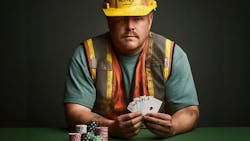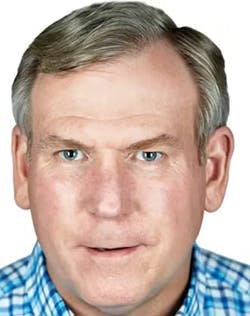How has the role of reliability manager widened over the past 10 years?
Last January, ChatGPT and generative AI took the world by storm as the latest technologies of several poised to change manufacturing and heavy industry. To kick off the new year, Plant Services asked several expert practitioners and consultants to tackle questions on the ways that technology and market forces have shaped the M&R industry over the past 10 years.
Jeff Shiver, CMRP, is founder and managing principal at People and Processes, a global consulting and education services firm focused on physical asset management. As a contributing editor for Plant Services, his From The Plant Floor column addresses the daily challenges that keep organizations from overcoming their struggles with asset maintenance and reliability. In this interview, Jeff outlines the ways that the role of reliability manager has widened in scope over the past 10 years, and the challenge of attracting new talent to the M&R labor pool.
1. How has the core skill set (and/or toolbox) of the average mechanical plant millwright changed over the past 10 years?
First, there's a lot of issues around the plants being at capacity. They're trying to produce everything that they can, and they can sell everything they produce. If we think about the millwright, specifically, they’re doing a lot more with technology. There's a lot more automation, controls, and instrumentation than in the 10 years prior. There's a lot more push to put things in a CMMS to build better data, there's a lot more technologies, online and offline in use, like vibration, infrared, ultrasound to monitor the assets. There’s also a big focus on sustainability, energy efficiency, renewables, and so they're having to shift their focus with regard to that as well.
In reality the expectation for core skill sets among new millwright hires is being at the journeyman level. When new hires come in, there's an expectation that they can step in and do the role, or basically hop on shift and do the best they can. Technicians that have the skills are being asked to train the others but not allowed the time. In the past too, we would find that the unions would take a very active role in training. That's not the case anymore, although it varies by union.
2. How has the core skill set (and/or toolbox) of the average reliability manager changed over the past 10 years?
For the reliability manager, the focus is shifting more and more to the following:
- Strategic asset management – especially when you get into water / wastewater and municipalities, there's a big push to go into asset management, ISO 55,000, long-term strategic asset plans, and maintenance plans as part of that.
- Data driven decision making – unfortunately, we still struggle here, as you see a considerable amount of time where we're either not getting the data in a timely fashion, or we're not acting on the data in the right way, or we're not even taking the data. For example, with one particular group that I worked with recently, they're getting data from a vibration vendor who's basically running the routes for them. By the time the report comes back to them and they can take action on it, the pump has already failed. And the frustration is, the vendor was here today, so why didn't we find out today that the point was in the act of failing? Why do we have to wait a month to get the report when in two weeks from now the pump fails? A different group pretty much abandoned a lot of their vibration, because they did not trust what the data were telling us, and felt they didn't get any value from it, so they stopped the service.
- Change management and the rate of change – some managers are really struggling with the rate of change in industry. Back 10 years ago, that rate of change was somewhat steady. I would say now, it's almost exponential, with regard to how many things change and the constant push. Unfortunately when management changes, oftentimes, so do the programs. Doing the right things and driving improved productivity and reduced costs, all those things can get pushed to the wayside.
- Financial acumen and risk management – there’s a much greater focus on risk management than in past years. For example, if you look at how criticality has changed, it used to be asset criticality, but now it’s moreso criticality to the business objectives. That's a significant step change: I'm not looking just at this process, I'm looking on how it impacts the overall business. As a manager, how do I become more financially aware and to be able to talk the lingo to connect our work to higher-level financial goals?
- Regulatory compliance and sustainability – there's a lot of issues around social expectations that are very different than 10 years ago, so you have to be much more aware with regard to the message you convey and your branding.
3. What kinds of Industry 4.0 technologies do you consider to be table stakes for current maintenance and/or reliability professionals?
We can see trends much further out when we combine data sets. We used to talk about just predictive work, but now moreso prescriptive. Based on the rules that you write, we can take vibration data and combine it with the quality data to get advance notification of impending failure. It also used to be we put just a few sensors on the machine, and it would get us overall health; now people put 60 sensors on the system, and it's not just vibration but a bunch of other parameters, like pressure and temperature, and they can come up with a much more fluid understanding of where machine health is trending.
Another piece you're seeing more focus on is the CMMS, to blend data and feed the CMMS and generate work orders automatically into the system. Cybersecurity is table stakes too, because of all the connected technologies. How do we make sure that we're managing cybersecurity in a way, especially on the automation side? Some plants I know have been hacked, or had ransomware installed on their machines. They have been ransomed and had to pay or they would see their SAP system down for eight months or more. This is probably one of the more important table stakes as we continue to combine more and more things.
With AI, I think we're getting closer to general AI as opposed to generative AI, but we're still not seeing that implemented on most plant floors. Those who do are paving the way for the rest of us.
4. Which industry verticals, if any, tend to be quick to embrace newer technologies like IoT or AI? (this can include public utilities)
Companies like automotive, aerospace have been quick to adopt some of these technologies. Energy, some of the public utilities are also relying more and more on some of this tech. When you get into a big company, say Amazon, and you take the automated warehouses, and you do the same thing for Coca Cola, or Walmart, or any of those other groups on the retail side, that even though those still have maintenance within their distribution centers, they're quick to adopt, you're seeing a lot more stuff there. How I manage the supply chain is part of that process, too, and I'm thinking about oil and gas here.
There's a lot of emphasis with some ports these days to get into the digital transformation world, for example with the cranes that load the ships, but again, it depends on the port and it depends on the leadership. For one of the ports we work with, the CEO has overall responsibility for maintenance of the cranes. He's the one who's driving that, and because of that, he's spending the money and contractor resources and doing things like that, and some of his people are getting those assignments to go do it. But it's driven by that upper level.
5. When new condition monitoring or asset management technologies are introduced, which members of the team are the ones driving these projects? Does it make a difference if the new technology is hardware or software?
I think it has more to do with the vision that is set by senior management, and by senior leadership. If it's specific to maintenance, you'll see the maintenance manager or the reliability engineer take that responsibility on. If it's more to operations, you'll see the operations manager taking it on, so it's fairly role specific.
If it's hardware, it might just be a maintenance manager, or maybe some reliability technician is assigned that responsibility to go around and put sensors on the pumps and drive trains. If it's software, like a CMMS, you’re going to have IT involved in that. It also may be that because of the expense it becomes a capital project, and a project engineer owns it, which interfaces into the maintenance realm, with the reliability engineer involved.
6. In your opinion, what are one or two things that would make an impact in alleviating the hiring challenges currently associated with the M&R job market?
One of the things we have to do too, and this is really key, is how do we change the perception of maintenance as a career path? And how do we manage the outreach into the high schools and similar places? I will give you a frightening statistic. I happen to have personal knowledge of a particular vocational technical school that covers probably a 120-mile radius, and in their electrical program, they don't teach until after 5:00pm. You know how many students they have? Three. It’s a 120-mile radius, and they have three megatronics students and that’s it.
Inside the plant, apprenticeship and mentorship programs are one piece missing, along with continuous upskilling and learning opportunities within the facility. Another is collaboration with educational institutions, Some companies, for example, like ArcelorMittal with Nippon Steel and their partnership in Calvert, AL, they have state funded trainees and they have a training center on site, and they do a tremendous job there. If we go to Nissan, in Smyrna, TN, they have a training center on site that does a lot and is state funded, with a curriculum was set up specifically for that plant.
Get the big picture. Read the full interviews with:
- Luke Clark, senior program manager for HECO Apollo
- Shon Isenhour, CMRP, founder and owner at Eruditio
- Chris Pepin, founder and managing partner at Progressive Reliability
- Jeff Shiver, CMRP, founder and managing principal at People and Processes
About the Author

Thomas Wilk
editor in chief
Thomas Wilk joined Plant Services as editor in chief in 2014. Previously, Wilk was content strategist / mobile media manager at Panduit. Prior to Panduit, Tom was lead editor for Battelle Memorial Institute's Environmental Restoration team, and taught business and technical writing at Ohio State University for eight years. Tom holds a BA from the University of Illinois and an MA from Ohio State University

